Today I’m kicking off a new blog series, and while the title is reasonably descriptive of the content, I thought it prudent to explain why this might be a good exercise for our development and for engineering friends.
Over the last 18 years in the stormwater industry, it should come as no surprise that I’ve seen a multitude of concepts and designs for drainage and slope stabilization. Some are good, some not so good. Now to be fair, I think it’s important to note that no matter what the problem, we always learn more from our failures than our successes. I say this to highlight that the goal here is not to shine the spotlight of shame on any individual or company but to learn from the mistakes of our past to become better designers.
Let’s face it. Most civil engineers don’t get the opportunity to get out in the field and see the long-term efficacy of their design. While most of the accepted engineering practices have already gone through the process of refinement to become standardized, detention ponds, sheet drainage, and slope stabilization still need some refinement. So the end goal of this series is to let you see some failures (as well as a few successes), so that you don’t have to repeat the mistakes of the past. I hope that, as a community, we can learn together to provide our customers with viable solutions instead of costly problems.
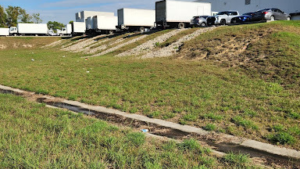
Today we’ll look at an interesting idea I’ve seen a few times and even fixed once. The idea is to sheet drain the property toward the detention pond, draining stormwater via curb cuts down the slope of the pond.
Let’s start with the why. But since we can’t ask the designing engineer, we’ll need to try to deduce the reasoning for this approach. Regardless of the situation, the answer is usually available space, time, money, or a combination of the 3. More often than not, it’s money. Architects and engineers are constantly battling with developers between the best way of doing things and the affordable way. As long as we don’t compromise structural integrity, the choice is left to the developer. If you know developers, you know that if a budget item can be cut or reduced, it will be. So why would you sheet drain to the detention pond in the first place when we’ve been using the same concentrate and convey system since the Romans? The reason, in this case, is price. By eliminating all of the underground drainage and storm inlets, you can save a substantial amount of money on materials and labor. Since the detention pond is required regardless of drainage, the only added expense is the extra underlayment and rock needed to prevent slope erosion as we drain stormwater down the pond slope. But does it work?
Back around 2010, I was called out to a college campus in Houston to take a look at a slope erosion issue in the detention pond. When I arrived at the site, I was shocked to see three of the four slopes looking great, but one had several rills so large that you could lose a motorcycle in each of them. Upon further investigation, I realized there were no catch basins or pipes in the parking lot. Instead, I found that the 2-acre parking area was designed to sheet drain toward the detention pond, which would then discharge through multiple curb cuts into the detention basin. To prevent the slopes from eroding, a geotextile fabric was laid out and covered with rip-rap. Unfortunately, the engineer failed to consider the erosive nature of moving water. I’m not necessarily talking about a deluge but more of a steady stream. Something I like to call the Grand Canyon effect. This erosion takes place slowly with little water. Not very exciting but highly effective, this type of erosion takes place over several years and can quickly undermine geotextile fabrics and stone.
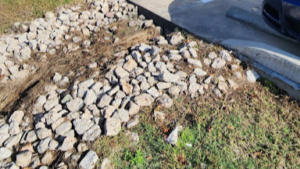
Our current example is similar in that it does not utilize catch basins and pipes to discharge stormwater to the detention pond. Instead, relying on sloped paving to drain stormwater to the detention pond via curb cuts. As seen in the pictures, the flows are starting to erode the soil below, creating a concentrated, channelized flow that will only exacerbate the problem.
Additionally, you can see that the 3×5 stone is being undermined and washed out at several locations along the slope.
These areas of erosion are a maintenance nightmare, requiring constant attention. Note that these areas have been repaired several times, only to re-appear after several months. In Houston, we receive approximately 50 inches of rain per year. This site is about 10 acres, with approximately 5 acres draining into this pond. This equates to about 6.5 million gallons per year. I wonder whether the engineer would have rethought this idea had he/she done this simple math, realizing that without some type of hard armoring, these slopes never stood a chance.
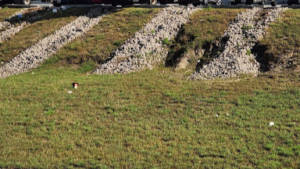
If left unrepaired, this erosion would eventually compromise the integrity of the adjacent parking area, so doing nothing is not really a sustainable option. The hard reality is that these areas must be maintained. The cost to remove, regrade, and replace just this slope would be $50K minimum. Additionally, mowing is going to cost more because maneuvering around these areas is time-consuming. And with mowing, it’s all about time. More time on site = more expensive.
But all hope is not lost. There is a solution…but it’s not free. Remember earlier when I said I fixed one of these? That was over 10 years ago, and the solution has stood the test of time. The picture below shows how we resolved this problem. We closed the curb cuts and added a curb inlet and pipe to drain the stormwater to the pond floor.
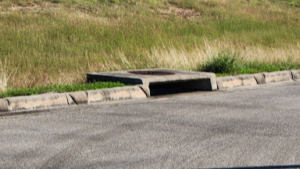
In most circumstances, a curb inlet of this size could easily drain 2 acres. But unfortunately, we had to add three of them. This is due to the original design. Curbs are typically sloped to drain to the curb inlet. But in this case, the curb was designed to be flat to allow the stormwater to sheet evenly to the curb cuts. With our fix, we couldn’t create the slope required without ripping up the parking lot. So instead, we relied on head pressure to drain to these three curb inlets. The cost for this repair (including regrading and stabilizing the pond was almost $100,000. Not cheap, but the problem was solved, and this is what it looks like 12 years later.
As you can see, this pond isn’t being mowed as the owner has moved, and the building is unoccupied. What you can also see is that there is no erosion, and the pond slopes are intact and most importantly, maintainable.
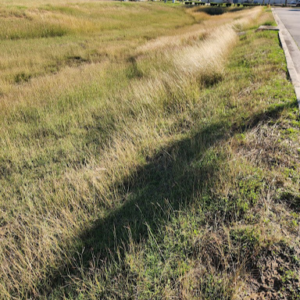
Unfortunately, the owner would not have needed to perform any of these repairs if the drainage had been correctly designed in the first place. The net cost would have been less had the decision been made to sheet drain to 1 or 2 curb inlets instead of the curb cuts, geotextile fabric, and stone.
So what’s the takeaway here? I think, as engineers, it’s essential to look at the mistakes of the past to be better designers today. But be forewarned, in the quest to build a better mousetrap, sometimes we need to realize that the mousetrap we are currently using is highly effective and maybe doesn’t need to be redesigned. Can we make the wheel any rounder? Is this an exercise in futility and, therefore, a waste of time and resources? We don’t want to discourage creativity and thought, but only through experience do we gain the knowledge to know when and where to think outside the box. Otherwise, we could just be spinning our wheels.
